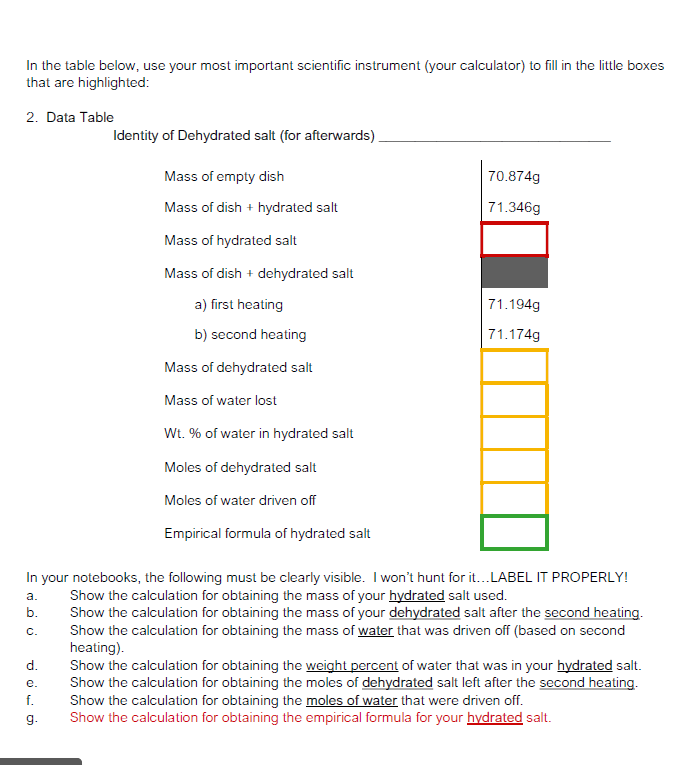In the table below, use your most important scientific instrument (your calculator) to fill in the little boxes that are highlighted: 2. Data Table Identity of Dehydrated salt (for afterwards) ________________________________ Mass of empty dish 70.874g Mass of dish + hydrated salt 71.346g Mass of hydrated salt Mass of dish + dehydrated salt XXXXXXX a) first heating 71.194g b) second heating 71.174g Mass of dehydrated salt Mass of water lost Wt. % of water in hydrated salt Moles of dehydrated salt Moles of water driven off Empirical formula of hydrated salt a. Show the calculation for obtaining the mass of your hydrated salt used. b. Show the calculation for obtaining the mass of your dehydrated salt after the second heating. c. Show the calculation for obtaining the mass of water that was driven off (based on second heating). d. Show the calculation for obtaining the weight percent of water that was in your hydrated salt. e. Show the calculation for obtaining the moles of dehydrated salt left after the second heating. f. Show the calculation for obtaining the moles of water that were driven off. g. Show the calculation for obtaining the empirical formula for your hydrated salt.
In the table below, use your most important scientific instrument (your calculator) to fill in the little boxes
that are highlighted:
2. Data Table
Identity of Dehydrated salt (for afterwards) ________________________________
| Mass of empty dish | 70.874g |
| Mass of dish + hydrated salt | 71.346g |
| Mass of hydrated salt | |
| Mass of dish + dehydrated salt | XXXXXXX |
| a) first heating | 71.194g |
| b) second heating | 71.174g |
| Mass of dehydrated salt | |
| Mass of water lost | |
| Wt. % of water in hydrated salt | |
| Moles of dehydrated salt |
| Moles of water driven off | |
| Empirical formula of hydrated salt |
a. Show the calculation for obtaining the mass of your hydrated salt used.
b. Show the calculation for obtaining the mass of your dehydrated salt after the second heating.
c. Show the calculation for obtaining the mass of water that was driven off (based on second
heating).
d. Show the calculation for obtaining the weight percent of water that was in your hydrated salt.
e. Show the calculation for obtaining the moles of dehydrated salt left after the second heating.
f. Show the calculation for obtaining the moles of water that were driven off.
g. Show the calculation for obtaining the empirical formula for your hydrated salt.

Trending now
This is a popular solution!
Step by step
Solved in 2 steps with 1 images







